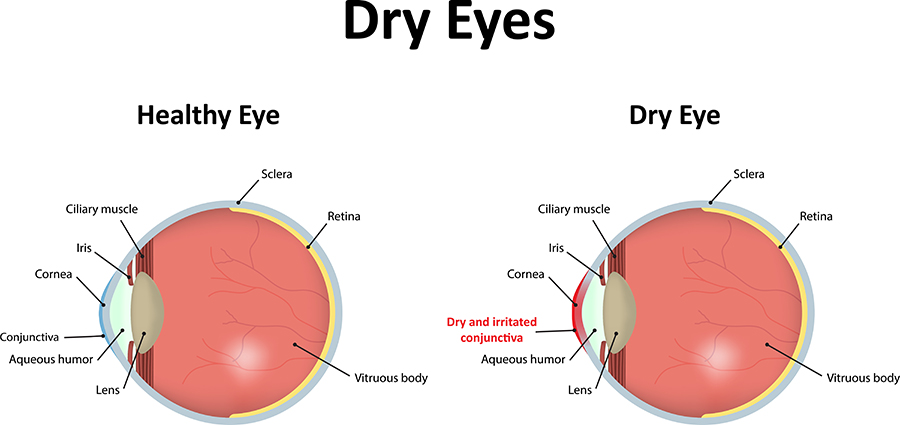Dry Eye Services in North & South Carolina
Dry eye, also known as dry eye disease, is a common condition when your tears aren’t able to provide adequate lubrication for your eyes. Tears can be inadequate for many reasons. For example, dry eyes may occur if you don’t produce enough tears or if you produce poor-quality tears. Common symptoms include:
- A stinging, burning or scratchy sensation in your eyes
- Eye redness
- Eyes feel “tired”
- Difficulty wearing contact lenses
- Watery eyes, which is the body’s response to the irritation of dry eyes
- Blurred vision
You may also experience dry eye irritation in certain situations, such as on an airplane, in an air-conditioned room, while riding a bike or after looking at a computer screen for a few hours.

What are the different types of Dry Eye?
There are two major categories of dry eye:
- Aqueous deficient dry eye disease represents a diminished production of water and therefore a reduced amount of tears.
- Evaporative dry eye disease is the result of insufficient oil (lipid) within the tears. This creates a situation in which the tears evaporate much too quickly resulting in poor tear stability and lubrication.
The treatment for dry eye depends on whether the dry eye is evaporative (oil deficient) or aqueous deficient (lack of water). Aqueous deficient dry eye is treated with artificial tears and gels. Your eye doctor may also suggest plugs inserted into the ducts that drain tears from your eye to your sinuses. This keeps the tears in contact with the eye longer. They may also use prescription eye drops, oral medications, or vitamin supplements (containing omega 3 fatty acids) depending on the type and severity of the dry eye.
Meibomian Gland Dysfunction
Meibomian gland dysfunction (MGD) is the most common cause of dry eye disease. There are about 25 to 40 meibomian glands in the upper eyelid and 20 to 30 in the lower eyelid. The function of these glands is to secrete oils onto the surface of the eye. These oils help keep the tears from evaporating too quickly.
The top method of treating MGD is to restore the function of the oil-producing glands lining the rim of the eyelid. This is best accomplished by LipiFlow®, a procedure that uses heat and massage to re-establish the function of most of the glands. There are also artificial tear supplements which attempt to replenish the oil component.
Blepharitis is a common and ongoing condition where the eyelids become inflamed (swollen) due to an overgrowth of normal bacteria living along the lid and the base of the eyelashes. While the underlying causes of blepharitis aren’t completely understood, it can be associated with a bacterial eye infection, symptoms of dry eye or certain types of skin conditions.
Since the eyelids are difficult to clean this overgrowth of bacteria can worsen over the years.
With the BlephEx® treatment your eye doctor can precisely and safely, clean and exfoliate your eyelids and lashes, which should almost immediately improve your symptoms. More importantly, completely removing the toxins along the lid margin helps you avoid long-term inflammatory damage to your tear glands, helping to treat or prevent dry eye syndrome. The treatment only takes a few minutes and is well tolerated. Regular treatments can effectively result in a cure of dry eye disease in many patients.
If you’ve had signs and symptoms of dry eye, see your eye doctor to diagnose the type of dry eye you have. This will allow you and your doctor to determine the best treatment plan to meet your individual needs.
For more information or to schedule a dry eye evaluation call (910) 295-2100 or toll-free at (800) 733-5357.



